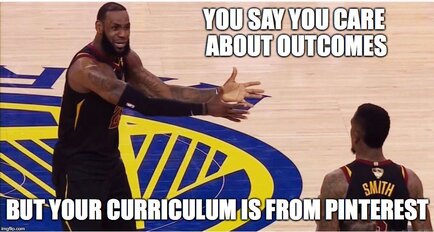Curriculum Series, Part 1 [Meme showing LeBron James. "You say you care about outcomes, but your curriculum is from Pinterest."] [Meme showing LeBron James. "You say you care about outcomes, but your curriculum is from Pinterest."] This is the first in a series on the practical side of implementing high-quality curricula. Part 1: The Power of a Quality Curriculum Part 2A: Assumptions & 2B: More Assumptions Part 3: Choosing a Quality Curriculum Part 4: Implementing a Quality Curriculum (Coach/Admin Edition) Part 5: Implementing a Quality Curriculum (Teacher Edition) When I was a kid, my family moved a lot. I went to four different schools between kinder and 4th grade. I remember coming home one day from that fourth school, and telling my mom, “We’re learning about bees again. Why do we study bees every year?” You see, I was under the logical (yet, false) assumption that someone (maybe the president?) had determined what a kid should learn every year -- and that bees only needed to be studied once in elementary school. Don’t get me wrong, bees are fascinating. It’s just that there are other insects deserving of study -- not to mention all the other animals. I know a lot more about education now, but as Natalie Wexler points out in The Knowledge Gap (2019), our educational standards describe many processes, skills, and strategies that students are supposed to learn, but are vague on the content that students should be processing and strategizing about. That’s where having a high-quality curriculum can shine a light. When I say “high-quality” curriculum, I am talking about those literacy curricula that align with the current best evidence about how children learn to read. These curricula are explicit and systematic in teaching decoding, and they intentionally build world knowledge. They also avoid teaching counterproductive strategies, like the three-cueing system. (Check out edreports.org for more information about excellent curricula.) Such curricula are powerful in a way that the old-school basal programs were not. As a literacy coach, curriculum coordinator and teacher, I’ve seen three main ways that power manifests: A high-quality curriculum is coherent. What my little fourth grade heart desired was coherence -- a curriculum that put a stake in the ground about what should be learned each year, how that knowledge should build, and how it all links together. According to cognitive scientist Daniel Willingham (2006), that coherence isn’t just elegant, but helps us learn: “A rich network of associations makes memory strong: New material is more likely to be remembered if it is related to what is already in memory.” A colleague and I saw this in action last year, when we tested out a module from the EL Education first grade curriculum. The module topic was sun, moon, and stars. Because of the coherent, systematic knowledge-building, our first graders were able to articulate deep understanding of why we have day/night and seasons. These same concepts were ones that our fifth grade students were struggling to comprehend in science class. A high-quality curriculum also drives equity. Recently, TNTP (2018) found that out of 180 hours of instruction, 133 hours are spent on activities that are not on grade level. Almost 40% of the study classrooms with a majority of students of color had NO assignments on grade level, compared to 12% of classrooms with a majority of White students. This is, frankly, appalling. However, many teachers aren’t given the resources to align their instruction to a high bar of excellence. For example, I witnessed a lesson in which the teacher followed the district-provided curriculum, trusting that she was given a quality resource. The curriculum did not align to grade level standards for complex text, and one of the second grade vocabulary words was basketball. Compare that to vocabulary words in a highly-rated, Common Core-aligned curriculum for second grade: compassion, visible, and respond. In which classroom would children be on the road to being college- and career-ready? Finally, a high-quality curriculum can build teacher capacity. A colleague of mine says, “Teaching a good curriculum is the best professional development.” It can help us understand standards, teach us new pedagogical methods, and introduce us to new texts and topics. More importantly, it can shift the teacher’s time and focus away from scrambling for materials, to diving deep into lessons and considering how students will be impacted. We can unleash this power in classrooms throughout our country. However… a series of myths about curriculum persist. I’ll discuss those in Part 2.
2 Comments
9/16/2019 06:40:27 am
Catlin - YES YES YES! To all of this, to infinity and beyond. Can we podcast with you about how you so artfully merged the key ideas from several BIG research studies and authors to cohesively bring this together? Thank you for your work. I'm impressed with your ten year old insight, and how spot-on your gut instinct was at that time. Sadly, we haven't fixed the knowledge gap yet - but hopefully we are on our way to reform education as we know it.
Reply
9/16/2019 04:08:03 pm
Thanks, Lori, for your kind words! Feel free to reach out to me via info on contact page. I've never podcasted before but would be willing to try! (I just listened to the "Why Curriculum Matters" episode and it was great!)
Reply
Leave a Reply. |
Click the categories below for entries on specific topics.
AuthorCatlin Goodrow, M.A.T Archives
December 2022
Categories
All
|
 RSS Feed
RSS Feed
